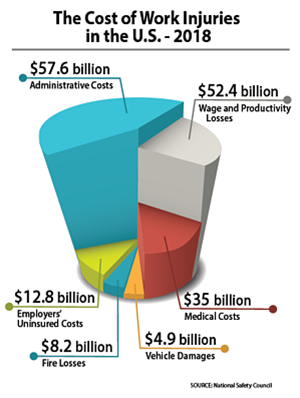Warehouse accidents take both a human and financial toll. Families and colleagues depend on warehouse associates – at home and at work – so the goal is that they leave work just like they came in. When injuries occur, the direct and indirect costs can have an impact on company profitability that can be felt all the way to the boardroom level. So preventing warehouse accidents must be a priority for all corporate and commercial logistics operations. This article explores the most important strategies to prevent warehouse accidents.

Let’s first look at the 10 most common causes of warehouse accidents, according to the Occupational Safety and Health Administration (OSHA).
- Forklifts. According to the National Safety Council, forklifts were the source of 78 work-related deaths and 7,290 nonfatal injuries involving days away from work in 2020.
- Hazard communication. Chemical burns can result from spills of un-labelled or mis-labelled hazardous materials.
- Electrical, wiring methods. Electrocution due to sub-standard wiring, including temporary wiring, is a major cause of warehouse accidents.
- Electrical, system design. Electrocution can also result from electrical systems that do not meet OSHA standards in terms of design and maintenance.
- Guarding floor & wall openings and holes. Slips, falls, and trips account for 15% of accidental deaths in the workplace.
- Exits. Injury and death can result during a fire or other hazardous event when pathways to exits are obstructed and exit signs are not clearly visible.
- Mechanical power transmission. Serious injury including amputation can arise from improper usage of mechanical/power equipment and parts.
- Respiratory protection. Respiratory illness and injury can occur when a warehouse is not properly ventilated.
- Lockout/tagout. Lockout/tagout programs are crucial in preventing equipment from being accidentally energized and injuring associates.
- Portable fire extinguishers. Workplace fires and explosions kill hundreds and injure thousands of workers each year. Portable fire extinguishers are an important part of any fire prevention program.
What is the Cost of Workplace Accidents?
Accidents in all these areas are incredibly costs for companies, both at a personal and profit line level. Data from the National Safety Council puts the cost of work injuries in the U.S. at $170.8 billion when you add up healthcare costs, insurance costs, lost time, productivity dips and other negative consequences. Here’s where that money goes.

As reported by Optimum Safety Management, on average employers will spend $120,000 on each workplace injury. Companies operating at a 10% profit margin would need an additional $1.2 million in sales to pay for the injury.
To prevent warehouse accidents, there are literally hundreds of small steps that can be taken, but success is mostly a product of two primary strategies: rigorous training and establishing a culture of safety across all warehouse operations.
Training to Prevent Warehouse Accidents
When it comes to warehouse safety and training programs, too many companies see them as an OSHA-mandated overhead expense rather than an investment.
It’s true that such training programs cost money, but warehouse accidents will cost you a lot more money. According to OSHA, businesses see an average return of $4 to $6 for every dollar invested into their workplace safety programs. So investing in training to prevent warehouse accidents makes good business sense.
The chief task of training warehouse associates is NOT training on specific safety procedures. That’s the easy part. The real challenge is to break through complacency. Some warehouse jobs can involve constant repetition of the same tasks. When that happens, associates can go into “auto pilot” mode and lose focus. That’s when warehouse accidents happen.
The best metaphor might be driver training. Driving instructors can drill you on the DOs and DON’Ts of turning and braking and parking. But they can’t teach focus. On a long car ride, it’s easy to lose focus for a split second and drift toward the adjacent lane. 99.99+ percent of the time, a momentary lapse in focus has no consequences. But for that very small percent of cases, the results can be catastrophic – on the highway and in the warehouse.
While you can’t “teach” focus, you can certainly emphasize it in safety training.
The bulk of warehouse safety training can and should emphasize those things we know are the primary causes of warehouse accidents – things like slips, trips and falls and injuries sustained while lifting. Often, injuries happen when people are hurrying and skirting basic safety procedures. That’s why constant reminders of how to avoid predictable hazards, via safety training, are so important. Read our article on warehouse safety training for tips on how to improve your training program.
Training can be job specific, but for many safety risks it’s important to train across job types. For instance, it’s not just vehicle operators that need forklift safety training, it’s all the people in the warehouse.
Training to prevent warehouse accidents is more important now than ever since injuries appear to be on the rise. The sharp increase in eCommerce orders due to COVID has created a need for more warehouse associates. More people results in more potential for injury. On top of that, the relative shortage of workers has led to more overtime and more people working when fatigued – tell-tale precursors to warehouse accidents.
It’s during these times – when the pressure is high to maximize throughput and get orders out the door – that companies can de-prioritize warehouse safety training because they feel they can’t pull associates off the floor to attend a class. This is a dangerous and counter-productive approach since it will lead to an increase in injuries and the onerous, injury-related costs noted earlier.
Preventing Accidents by Establishing a Culture of Safety
Superior safety performance is not going to result from covering the warehouse walls with banners like “Safety is no accident” or “Spill, slip, hospital trip.” It will be the product of driving accountability for safety to the associate level and empowering those who do the work.
That’s not a program; that’s culture.
The job of driving a culture of safety in logistics starts at the top. If the top boss talks safety regularly, associates will recognize that safety is simply endemic to the culture and will act accordingly. The CEO must make it clear that safety is a top organizational priority that gets measured and impacts performance reviews. Otherwise, all the posters, training and speeches will come across as so much lip service.
Making safety performance visible to all associates is important within a safety-conscious culture.
At KANE, we clearly display our current days without incident metric, as well as other safety and compliance measures. Associates take ownership of these numbers and have a sense of pride in delivering top safety performance.
This transparency can create healthy competition that you can leverage to spark greater interest and safety awareness in your organization. Let’s face it, humans are hard-wired to like games and competition. At KANE, we encourage friendly competition among KANE facilities and reward facilities that demonstrate the best performance. The desire to win creates some fun and excitement, but also helps us achieve the ultimate goal of reducing our RIR (recordable incident rate).
Establishing a culture of safety in your warehouse operation doesn’t happen over weeks or months. It takes years to drive ownership of safety from a handful of people with the word “safety” in their titles to every single person on the warehouse floor.
The more you can move the job of safety out of the hands of safety managers and into the hands of the people who do the work, the better.
- Bitcoin
- blockchain
- blockchain compliance
- blockchain conference
- coinbase
- coingenius
- Consensus
- crypto conference
- crypto mining
- cryptocurrency
- decentralized
- DeFi
- Digital Assets
- ethereum
- KANE Blog
- Logistics Safety
- machine learning
- non fungible token
- plato
- plato ai
- Plato Data Intelligence
- Platoblockchain
- PlatoData
- platogaming
- Polygon
- proof of stake
- W3
- zephyrnet











